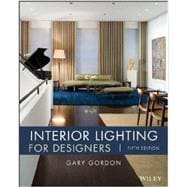
Note: Supplemental materials are not guaranteed with Rental or Used book purchases.
Purchase Benefits
What is included with this book?
Chapter 1
The Lighting Design Process
Chapter 2
Perception and Vision
Perception of the world around us is based not on the quantity of light entering the eye, but on the quantity of contrast.
Visible Light
The Eye and Brain
Brightness Perception
Color Perception
The Sense of Sight
Chapter 3
Light and Health
Much as the ear has two purposes—for hearing and balance—so does the eye. Light entering the eye gives rise to vision—and also governs the daily rhythms in all animals, including humans.
Photobiology and Nonvisual Effects
The Aging Eye
Seasonal Affective Disorder
Assisted-Living and Elder-Care Facilities
Chapter 4
Psychology of Light
Because the sense of sight is contrast sensitive, the brightness contrast of a space determines its emotional impact.
Emotional Impact
Degrees of Stimulation
Degrees of Brightness Contrast
Low-Contrast Environment
High-Contrast Environment
The Three Elements of Light
Subjective Impressions
Impressions of Spaciousness
Impressions of Perceptual Clarity
Impressions of Pleasantness
Vertical Surface illumination
Certainty
Variation
Chapter 5
Patterns of Brightness
Specifying the direction and distribution of light in a space yields the desired brightness contrast.
Brightness vs Luminance
Direction and distribution of light
Surface Finishes and Reflectances
Secondary Light Sources
Three-Dimensional Form
Glare and Sparkle
Direct Glare
Visual Comfort Probability (VCP)
Reflected Glare
Sparkle
Chapter 6
Color of Light
Color is not a physical property of the things we see—it is the consequence of light waves bouncing off or passing through various objects.
Color Temperature
Color Rendering
Subjective Impressions
Surface Finishes and Color of Light
Incandescent Sources
Fluorescent Sources
High-Intensity Discharge (Hid) Sources
Chapter 7
Measurement of Light
Quantitative Illumination
Measurement Limitations
Luminous Intensity Distribution Curve
Chapter 8
Daylight
Daylight Design
Fenestration Sections
Tubular Skylights
Managing Solar Heat Gain
Shading Devices
Movable Controls
Stationary Controls
Glazing Materials
Quantity of Interior Daylight
Chapter 9
Incandescent and Halogen Lamps
Lamp Bases
Filaments
Light Output
Lamp Types
Nondirectional Sources
Semi-Directional Sources
Directional Sources
R Lamps
AR and MR lamps
PAR Lamps
U.S. Legislation
EPACT
EISA
Tungsten-Halogen Lamps
Halogen Infrared (IR) Lamps
Low-Voltage Lamps
Colored Light
Color Filters
Colored Lamps
Chapter 10
Low-Intensity Discharge Lamps
The New copy of this book will include any supplemental materials advertised. Please check the title of the book to determine if it should include any access cards, study guides, lab manuals, CDs, etc.
The Used, Rental and eBook copies of this book are not guaranteed to include any supplemental materials. Typically, only the book itself is included. This is true even if the title states it includes any access cards, study guides, lab manuals, CDs, etc.